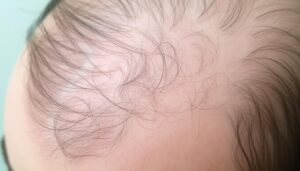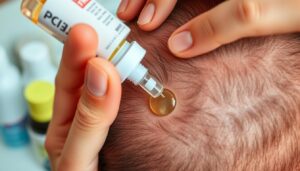Are you tired of thinning hair and the frustration of male pattern baldness? If so, you’re not alone. Millions of men struggle with this common issue. A popular treatment option, finasteride, has gained a lot of attention. But the big question remains: does finasteride actually work?
In this comprehensive guide, we’ll explore the science behind this FDA-approved medication. We’ll look at the clinical evidence to find out if finasteride is effective for hair loss.
Key Takeaways
- Finasteride is a prescription medication that works by blocking the production of dihydrotestosterone (DHT), a key driver of male pattern baldness.
- The recommended dosage is a once-daily 1 mg tablet, and it can take several months to see the full results.
- While generally well-tolerated, finasteride may have potential side effects, including sexual dysfunction, which should be discussed with a healthcare provider.
- Hair loss solution: Scalp Micropigmentation
Understanding Finasteride
Finasteride is a well-known treatment for male pattern baldness. Finasteride is a 5-alpha reductase inhibitor. It works by stopping the production of a hormone that causes hair loss.
This hormone, dihydrotestosterone (DHT), is key in male pattern baldness, which affects millions of men. It causes these follicles to shrink and eventually stop working, leading to a receding hairline and thinning hair on the scalp.
Recommended Dosage and Administration
The recommended dosage of finasteride is 1 milligram (mg) taken once daily. It’s best to take it orally, with or without food. Consistency is key to the best results. Finasteride results after 6 months tend to be relatively good. However, one should wait 12 months for the full effect of the treatment. https://www.youtube.com/watch?v=rWU7ErxmpeQ
Understanding how finasteride works can help those with male pattern baldness. It lets them make informed choices about their treatment. This way, they can aim for the finasteride success and finasteride before and after results they desire.
Does Finasteride Work
Finasteride is a common treatment for male pattern baldness. It has been studied a lot. Many studies show it works well for treating hair loss and growing new hair.
A big study found that 83% of men saw more scalp hair after a year of treatment. Also, 66% noticed a clear improvement in their hair loss. These finasteride progress results are seen in many studies, proving its effectiveness.
But, how well finasteride works can vary from person to person. Things like age, genetics, and how bad the hair loss is can affect results. This means some people might see better results than others. It’s key to keep an eye on how it’s working and adjust treatment as needed.
Hair Loss Solution: Scalp Micropigmentation
Hair loss can be a distressing experience for many individuals, leading to a growing interest in various solutions. One of the more innovative treatments gaining traction is scalp micropigmentation (SMP). This technique involves tattooing tiny dots on the scalp to replicate the appearance of hair follicles, creating the illusion of a fuller head of hair. This solution has much faster results than any medication.
Conclusion
All in all, while finasteride offers a scientifically-backed option for combating hair loss by blocking DHT production, it’s not the only solution available. The results can vary widely, and some may find that alternative treatments provide a more immediate or desirable outcome. Scalp micropigmentation (SMP) is one such alternative—a cutting-edge technique that creates the appearance of a fuller head of hair without the wait or side effects associated with medication.
If you’re ready to explore how SMP can restore your confidence and give you the look you want, come visit us at ScalpMasters. We have an amazing team of professionals who will help you every step of the way. Don’t let hair loss hold you back—contact us today to schedule a consultation and regain control of your look.











